This is a detailed review of the Strida folding bike, written after 10 years of riding a Strida. I’ve had three Stridas in that time and developed something of a love-hate relationship with them. I’ve come to find I simply can’t live without the fast folding, the ability to wheel it along when folded and the integrated child carrying (more on that later). The low maintenance of the bike overall and the clean belt drive are also great for an every-day city bike. The Strida has a very upright riding position which is perfect for seeing and being seen in traffic or when cruising along taking in the atmosphere.
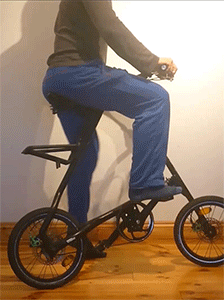
On the other hand, I’m constantly annoyed and frustrated by the significant shortcomings of this bike. The upright position creates a lot of drag, making the Strida very slow, especially into a head-wind. For longer rides, the upright position also gets very uncomfortable putting all my weight on the saddle. The strange geometry also means I can’t pedal standing up, take my hands off the bars or bunny hop a curb. On the rare occasions that this bike needs any maintenance I’m frustrated by the poor availability of spare parts and the near impossibility of finding anyone who knows how to adjust the gears on my current Strida MAS model.
The Strida is a strikingly elegant bike which has a number of unique advantages and disadvantages:
The good:
- Incredibly quick fold and unfold, especially the partial fold
- You don’t have to carry it when folded, it still rolls on its normal wheels
- I’ve found I can comfortably carry a child without affecting the folding ability
- Very low maintenance
- Clear belt drive
- Upright riding position is good in city traffic
- Effective and simple cable disc brakes
The bad:
- Upright riding position
- Not comfortable for long rides
- Very slow, especially with a head wind
- Very strange geometry
- Makes riding out of the saddle almost impossible
- Wheelies and bunny hops are nearly impossible
- Combined with 16” wheels makes navigating obstacles such as curbs very difficult
- Only two gears with a limited range
Contents of detailed review:
- My history of Strida ownership
- Folding and unfolding
- Ride and handling
- Specifications
- Luggage and Child Carrying
- Maintenance
- How the Strida Looks
- Conclusion
My history of Strida ownership
The Strida was first created by Marc Sanders in 1987 but I first bought a Strida MK3 in 2007. At first, I found it very strange to ride and awkward to fold and unfold. After a few days, I started to love the unusual upright but responsive ride. After I found folding instructions on YouTube I realized how quick and easy the Strida is to fold and unfold. I believe it is the fastest bike to fold and unfold. Before long I could step off the bike before it had come to a complete stop and have it folded within my first stride, without even stopping!
As explained below it is easy to break the ball joint when unfolding the Strida. This resulted in the bike being off the road for several days waiting for a replacement. This was my first experience of the difficulty in finding spares for the Strida. The Strida MK3 had plastic molded wheels and drum brakes located inside the plastic hubs. I found that on a long descent into Bath (about 120 meters elevation loss) the wheels would start to melt. It quickly became apparent to me that this was a design fault. The wheel’s plastic material has a low thermal conductivity and so the heat generated by braking could not escape quickly enough. A rapid increase in temperature when braking for prolonged periods of time was, therefore, to be expected. Combine this with the fact that the plastic wheels had a low melting temperature and this dangerous fault should have been anticipated during design. It took me some time to persuade the Strida dealer of this point but in the end, I was supplied with an upgraded set of spoked wheels with metal hubs free of charge.
The next Strida I purchased was a Strida MAS in 2010. This was identical to my current bike in most respects. That bike was written off when I was hit by a car entering a roundabout I was on. I’d had it for almost exactly two years when it was destroyed. The gears had just started to need alignment after working perfectly with no maintenance despite daily use for the whole two year period.
Folding and unfolding the Strida
Folding is what really sets the Strida apart. While other folding bikes, like Brompton, aim to achieve the most compact folded package, Strida takes a different approach. With a Strida it’s about how quickly and easily you can fold and unfold, and how easy it is to wheel the folded package along. Yes that’s right, unlike other folding bikes you don’t have to carry it when folded. For me this is a huge advantage. Also, although the folded package is quite long, it has a small footprint making it easy to store in many spaces. I hang mine on the wall in the house which works perfectly.
The folding process for the Strida can be divided into two stages. The first stage is a single action to fold the frame into a stick-like package with the two wheels side-by-side. The Strida can then be wheeled along either in front of you or trailing behind you. This quick fold only takes about two seconds and is perfect for nipping into a shop or jumping on a train. Here’s a short video showing how quickly the Strida can be folded and unfolded.
The next stage is to collapse the handlebars and the pedals. In many cases it is not necessary to do the second stage at all but when needed I usually do it as I’m wheeling the Strida along.
The quick first stage fold is probably the fastest folding bike available. I can step off the bike while moving and have it folded within my first stride. This makes other folding bikes look very tedious.
I prefer to push the folded Strida in front of me and find this is more maneuverable. If I need to wheel it for a long distance then trailing it behind is easier but in this case normally just push the unfolded bike.
A Better Bicycle is Coming…
The Better Bicycles team of researchers and engineers aim to make cycling more convenient and enjoyable. Our revolutionary design concept now has UK Government funding to bring it to market. Sign-up to give your feedback on design evaluations or even attend prototype testing sessions.
Another advantage of the stick-like fold is that when you’re in small crowded space it is possible to hold the Strida in a very vertical position, close to your body. This means you are much less likely to bash your neighbors in the leg and it is a much more acceptable bike to take in and out of shops and offices.
One thing to be very careful of when unfolding is not to over-extend the frame. This is very easy to do and results in a broken ball joint which is the equivalent of the upper headset race. I did this several times before I got used to the unfolding process. There is also a risk of other people accidentally causing this type of damage. For example, if they need to move your bike to get to their luggage on a train. This is something to be aware of an be ready to help people get their luggage if you know you’re blocking it.
The Strida ride and handling
The geometry and ride of the Strida is very unusual. Most bikes I’ve ridden sit somewhere neatly on the sporty scale! Let me explain what I mean. At the sporty end, a road bike has a nimble responsive feel with a low stretched out riding position. At the completely unsporty end, a classic European city bike feels solid and stable with an upright riding position. The Strida mixes these qualities in an extreme and very unusual way.
A very short wheelbase, steep steering angle, almost no trail and narrow high-pressure tires combine to give the bike a very nimble and responsive feel. This makes it fun to ride, especially when nipping through narrow spaces in a crowded city. In this respect, the bike feels extremely sporty.
The very upright riding position couldn’t be any less sporty. The very poor aerodynamics combined with only two gears makes it impossible to ride very fast, especially into a headwind. This position also makes it difficult to deliver a lot of power to the pedals. The combination of the upright position and the very short wheelbase puts a low more weight on the front wheel than normal. This becomes even more extreme if you stand up while pedaling and I am completely unable to ride standing up. I’m also completely unable to bunny hop this bike.
Specifications of the Strida MAS
This review is focused on the Strida MAS which has a generally very high specification for a folding bike. The specification is fairly consistent across the current Strida range with the main difference being the gears with single speed
Gears
All Stridas use a belt drive. This is a very good choice for a folding bike as it is clean and low maintenance. Earlier models suffered from the belt slipping but the Gates belts on current models work extremely well.
The Strida MAS is fitted with the 2-speed Schlumpf Speed-Drive. This is an epicyclic gearbox mounted within the chain wheel with a shifting rod which runs down the center of a hollow bottom bracket shaft. The low gear is direct drive and the high gear provides a 65% increase in the final drive, a ratio 1.65. To change gear you tap a button on the end of the bottom bracket with your heel. I find this very easy and really like the absence of any cable or visible gear shifter
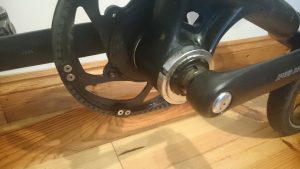
I have found the Schlumpf Speed-Drive works very well with virtually no maintenance for about two years. After this wear in the bearings causes play in the gears, grinding and dome missed gear changes where I get stuck in a neutral position. This is where some issues develop. Instructions are provided on the adjustment of the gears for play and the replacement of worn bearings. However, I have found it very difficult to correctly adjust the gears and I have been unable to find a cycle mechanic with experience in this.
Newer models use a 3-speed gearbox mounted inside the bottom bracket shell. I have not yet tested this.
Brakes
The mechanical disc brakes are generally excellent. This is a huge improvement over the caliper brakes fitted to many folding bikes or the drum brakes fitted to earlier Strida models. These brakes are powerful, well-modulated and work equally well in the wet. They are also very easy to maintain.
On one side there is a fixed brake pad which is simply adjusted as it wears using a hex tool. On the other side the actuated pad is adjusted by adjusting the cable tension, as with any form of mechanical break.
All of the current Strida models use these brakes.
Strida Luggage and Child Carrying
The Strida MAS comes with a small plastic rack which I have found to be quite pointless and rarely used. Its main function seems to be to stand the bike when folded. This rack was famously used by Viscount Linley to carry his daughter to school through the streets of London. This rack is definitely not a secure place to carry a child and this was widely criticised.
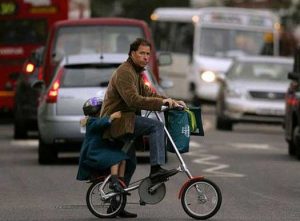
Due to the unusual geometry of the Strida I have found that a make-shift child seat can be fixed directly in front of the saddle. I’ve carried my children in this way between the ages of 2 and 9 years old. As far as I know the Strida’s ability to carry a child in this way is unique in that it has no effect on folding the bike. The folding process remains exactly the same and the folded size is also not effected in any noticeable way. Initially I simply used some closed cell foam fashioned into a simple saddle and secured with duct tape. More recently I’ve modified a small saddle and attached this onto the frame of the Strida, immediately in front of my saddle.
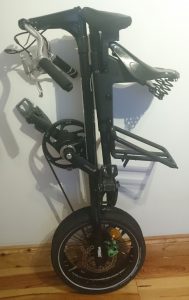
I should stress that this is purely from my personal experience. I am not recommending that anyone copies my method of child carrying at this stage. A full risk assessment and structural analysis must first be carried out.
Maintaining the Strida
In general, the Strida needs very little maintenance and is very reliable. My current Strida MAS is just over 5 years old and is still going strong. I’ve changed a belt, freewheel, ball joint, tires and brake pads. Each a couple of times. The rear wheel has needed several new spokes and the gears have been re-aligned. This is really very little work over a five year period. However, the problem with owning something so unusual is the difficulty in finding spare parts. I’m assuming that your local bike shop is not a Strida dealer since there is only one dealer in most countries. I’ve also found that the national dealer does not always have spare parts in stock. There may be an additional wait while the dealer obtains the parts from Taiwan. I would recommend that anyone relying on the Strida as their daily transport ensures that they always have some spares. These could be kept at home or carried on long rides.
As a minimum, you should have a spare ball joint and a belt. These are both parts which can fail suddenly without warning. If this happens your Strida will be completely unusable. Changing them is quite easy. If you have any experience with basic bicycle maintenance then you will have no difficulty changing these parts.
It may also be sensible to have a spare freewheel, a tool for changing the freewheel, some spokes and some brake pads. All of these are non-standard items that will need to be ordered when they need replacing. You are likely to get a bit more warning that these parts will need changing. It is, therefore, an option to just order them when that time arrives.
If you don’t want to have your Strida out of action for several days then I strongly suggest you take note of this advice.
How the Strida looks
The Strida is a design classic. It’s hard to imagine a simpler structure that could still function as a bike. This elegance certainly has an appeal. The tinny wheels and very upright position can also make it look a bit like a clown bike. So opinions seem to be very much divided on whether this bike looks cool. I certainly get a lot of attention riding it, most days I will hear some teenagers call out ‘sick bike mate’, ‘man that bike is nice’ or something similar as I pass. Middle-aged cyclists seem to find the looks just too different from the road and mountain bikes they are used to. I find a lot of more mature people are very much drawn to the simplicity of the design. You will have to decide for yourself if this bike looks cool and whether you want a lot of attention, or perhaps you couldn’t care less about all that!
Conclusion
In my opinion, the Strida is the best city bike available. The near instant fold/unfold is light years ahead of almost all other folders. The stick-like folded package is really easy to roll along in front of you, into a crowded shop, trains etc. The ride is not to everyone’s taste but I love the lively responsive feel. For me, the ability to carry a child without impacting on the fold is really important and also something no other bike can offer. It isn’t really suited to long rides, high performance or off-road use. But that’s really not the point of a bike like this. If you want a practical bike for nipping around the city then this is my first choice.
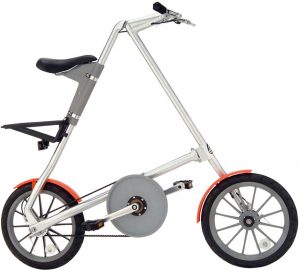
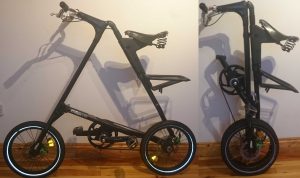
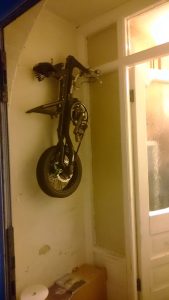
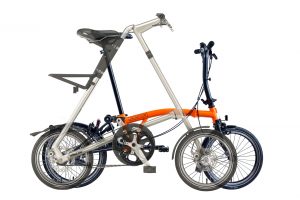
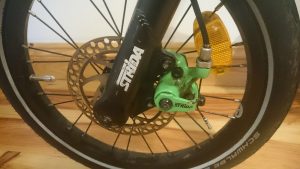
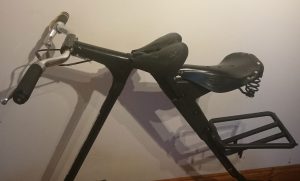
Thanks for the very balanced review.
I love my strida! Have had the same one since 2009 and still going strong. Replaced a the belt once and the freewheel once. I also modified it a bit to put on some wider marathon tires that never get punctures. Gives a more comfortable ride overall. I have gone up to 40km in a single ride on it at times.
Hi Doug, I’m interested in how you modified it for wider tires?
Jody
my view about STRiDA is exellent for first and last KM ride to take on PT low maintenance and easy to change tube/tyre ! the only bike single mount front/rear
Thanks Doug, once a STRiDA rider always a STRiDA rider…I love my STRiDA folding bike
need to know how to modify for wider tyres. plus make and size of new tyres. please. sound just what i need.
There are two wheel sizes, most Strida come with a 16″ wheel but note that this is the 305 mm bead diameter, not the more common 349 used by Brompton. Some Strida’s have a larger 18″ wheel (355 mm bead diameter). The frame is the same, so if you are using the smaller 16 wheel you will have more tire clearance than if using an 18 wheel. The 16 is normally supplied with a 2″ wide tire (50-305) and the 18 with a 1.25″ tire (32-355). There is only about 3 mm of clearance and due to the hub design, disc mounts and belt alignment it would be difficult to modify to take larger tires.
For the 16 wheels, I’d recommend Schwalbe Marathon (47-305) which is an excellent tire that seems virtually immune from punctures and rides very well. It definitely fits in the frame.
For the 18 wheels, the Marathon is only available in 44-355 which is too large to fit in the frame. There is a Marathon Racer available in 40-355, which is a really excellent tire but it would be extremely tight. You could stick with the standard Innova tire or try the Schwalbe Kojack (32-355).
What kind of hook did you use to fashion your wall mount? Quite interested in doing this.
Thanks….
Something like this:
https://www.screwfix.com/p/smith-locke-medium-duty-storage-hooks-zinc-plated-blue-sleeves-6-pcs/3982J?tc=UA7&ds_kid=92700058168040067&ds_rl=1244072&gclid=CjwKCAiA2O39BRBjEiwApB2Ikg6YIlm14Jhckl9nBpZ7dOixLqhxNj2Dt6JyyDAUh-KMymRjBlE3DRoCoc4QAvD_BwE&gclsrc=aw.ds
Hi. Enjoyed your reviews of the Strida. Thanks for sharing. Mine is the 3rd generation single gear model bought in 2005 in Singapore. It was ridden once weekly for the first 4 years and then was in storage for 11 years. Few months ago I brought it out of storage for recreational use. To my surprise I only needed to replace the 16 inch tyres. Bike mechanic said belt is still good!
With the covid pandemic everything is in shortage. Waiting to install a kick stand and possibly mud flabs.
Urgently I need a saddle that is more suited for riding through parks for 1-2 hour stretches. The original saddle is just too stiff and severely strains the lower back and buttocks.
Would appreciate your recommendation for a saddle replacement.
Thanks in advance.
Brooks flyer – this saddle made of leather and gots two springs. Fits to strida saddle mounting system of LT, SX and EVO.
With original saddle i got buthurt after half an hour in city. With Brooks I can ride for 4 hours without that problem.
Hi, I had chanced upon this post and loved reading the review of another long time Strida owner. I have owned 3 Strida bikes myself over the years (Strida 5, LT, EVO) and still have my 1st Strida 5 from 12 years ago. Although I’ve since gotten 2 Bromptons and another 14″ foldy, the Strida remains my first foldy and hence my “first love” 🙂
I agree with most of your comments. Just wanted to add that in my book, the low maintenance of the Strida is legendary. For 2 years during the pandemic, I had my Strida 5 locked partially shaded at work place. Since I was working from home, it was left outdoors at the mercy of the Singapore tropical sun and flash showers.
When I finally return the office, the Strida looked to be in really bad shape. The grips had half-melted off and the tyre side walls rubber threads have started to unravel and bulge out. I also needed to get a locksmith to angle grind through my bicycle lock that had rusted shut.
However, a quick change of tyres, a new set of (much nicer Strida leather) handlebar grips, and some oiling later, I was zipping around again on the Strida. I’m amazed how well most of the bike held up to my neglect, particularly the drivetrain (kudos to Kevlar!). I’m also rediscovering my love for the Strida. My Strida is now back at home and while I will not chose it over my Brompton (8kg) for commutes or long rides, it’s a special kind of joy to hope on to a Strida and cycle upright to my neighborhood cafes or store, collecting stares along the way. Cheers.
I think it’s better to consider Strida as a fast alternative to walking rather than cycling and a such, I don’t want to be without one, I’m here trying to find out if the quality has been maintained over the years. I think from your review, the answer is yes, but I might stick with the single speed.
I had mine about 20 years but the wheels got bigger on new models since, and it’s hard to source tyres. Now something stupid like a puncture is making me consider a modern upgrade to a bike which is starting to creak
While the tyre size is no common (and smaller than a Brompton’s), it should not be too difficult to source for new tyres. Search for Etro 40-305 tyres. Kenda makes a couple of models in this size—from regular 65psi to high pressure 100psi–but I think lists them as for kids bikes.
The creaking might be coming from the rear hinge and you can do something about that too. Do a search for Strida Trilock Rear Hinge System, andr Strida Canada West. Cheers.
You need to know how to shift on wide tires. The same goes for the brand and size of your new tyres. please. sounds exactly what I need.
Hi! I live in Barcelona, catalunya. I’m too happy to ear you. And happy too with my LT strida. Please visit my STRIDA BARCELONA instagram.
COME TO BARCELONA!
Thanks for the review. Very tempted to buy one. Would you be able to give a bit more information about how you attached the small child’s saddle?
Love my strida
All three of them an Lt a 3 speed and a
Very new but used sx( not sure if the bike is a fake since it’s quality is less then my LT The new bike has a pin to fold the bars instead of a cap so pressing it is painfull
The central qr lever on the stem /bars slips open And needs a tie cord ( ugly)
The red paint chips off with every knock
The wheels roll with more resistance
There was no rear to
had to purches a new one An aluminum one
Some one added a bunch of washers help the magnets make contacts and mostl importantly the wheels where really wonky they were so untrue with side wobble and up down movements so much that it was not safe and handled poorly
The bike had strida stickers on it and a scolloped rotor Trued wheels and a letters claiming MY FIRST WHEELCHAIR The bike is red just like the old Sony toys